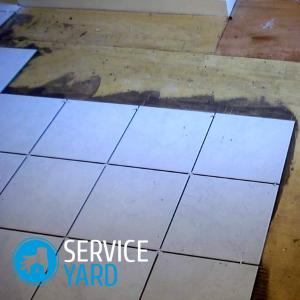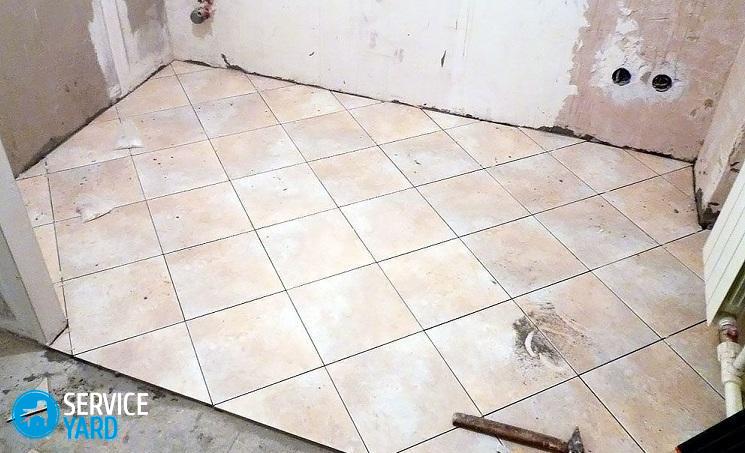Primer for a floor under a tile

When performing repair work related to tile laying, it is imperative to take care of the proper preparation of the floor foundation in order to achieve a high-quality sustainable result. The final step in this process is priming. Today we will tell you what a primer for a floor under a tile represents, how to properly prepare a surface for work in accordance with applicable rules.
to contents ↑The need for priming the floor before laying the tiles
As we said earlier, such a step as priming cannot be ignored. Carrying out this procedure positively affects the final result, in particular, affects the adhesion strength of the surface and tile, which is laid on the floor. But here it is important to figure out which primer to use before laying the tiles, because the result depends on the quality of this composition.
Important! In principle, any mixture can be used, but the traditional deep penetration primer mixture is ideal for this.
Thanks to the primer, the surface becomes:
- Homogeneous.
- Durable.
- Reliable.
Due to this, adhesive-based cladding materials reliably adhere to the base, which is why this preparatory measure cannot be called superfluous. By the way, this is the most common mistake made by unprofessional repairmen - they only primed walls, and floors do not undergo such treatment. This can turn into unpleasant consequences, of course, the material will not fall from the floor to the head, but the tile may shift in the future.
to contents ↑Important! The use of a primer should be the main rule for any tiler, so that the repair result is perfect, and the tile lasts for many years.
Preparing the floor for laying tiles
For many decades, it is the tile that has been considered the most popular type of flooring - it can be found in the bathroom, in the kitchen, in the corridor and in the bathroom. Today, tiles are often found in residential premises, such as a bedroom, living room, dining room. The secret to the relevance of this building material lies in its excellent performance. It has a long service life, resistance to abrasive substances and mechanical stress.
Important! In order for the material to last for a long time, it is necessary not only not to make a mistake with the choice of building material, but also to properly prepare the surface for installation.
The floor must be thoroughly cleaned of various kinds of contaminants before priming. When choosing a material, maximum attention should be paid to such operational qualities:
- Easy to clean.
- Wear resistance.
- Resistant to modern cleaning products.
After the building material is selected, you can begin to prepare the surface. So, if the floor in the room is concrete, then it is necessary to ensure that it is:
- Well dried.
- Absolutely smooth.
- Perfectly clean.
To prepare the floor, you must have the following tools and building materials:
- Mix for a coupler.
- Any container for the preparation of the solution.
- Mixer nozzle.
- Electric drill.
- Building level.
- Putty knife.
Important! Experts advise making a cement-sand screed before starting the facing work.Its main advantages are that after pouring and thorough drying, the surface is perfectly smooth and strong. The only drawback of this procedure is the increased level of soiling.
Before facing it is necessary to determine the thickness of the screed. As a rule, 4 cm is considered the optimal layer, in some cases its thickness increases to 7 cm.
Perform the following work:
- First of all, clean the base from dirt.
- Knead the screed mortar using an electric drill.
Important! In order for the composition to turn out without lumps and homogeneous, sift the sand carefully before mixing.
- Pour the solution evenly onto a clean surface.
It is necessary to wait a month before engaging in facing, so that the base dries. You can also equip a waterproofing layer. In addition, a primer for the tiles is carried out, the technology of which we will describe below.
to contents ↑The choice of material for priming
It depends on what soil you choose, how reliable the adhesion of the facing material to the floor will turn out. Impregnation is an essential component of any chosen technology for facing. The floor must be primed without fail.
What is a primer? Simply put, it is a liquid composition consisting of a mixture of special ingredients and fillers in a binder polymer. In order not to be mistaken with the choice of high-quality composition, it is necessary to take into account the appearance and condition of the surface to be treated, and the purpose of the room.
All primer mixtures by type of binder are divided into the following groups:
- Alkyd.
- Acrylic
- Polyvinyl Acetate.
- Glifthal.
- Perchlorovinyl.
- Phenolic
- Polystyrene.
to contents ↑Important! To prepare the floor before laying the granite, it is better to use acrylic compositions, but if in doubt, it is better to consult a specialist to help you choose the optimal type of material.
Technology of priming the floor before laying tiles
The primer of the floor before laying the tiles involves grinding the entire working surface with sandpaper or a special machine and the subsequent application of soil. If you carefully study the instructions, you can do this work on your own.
The floor should be cleaned with:
- Scraper.
- Washings.
- Spatula.
It will be necessary to perform such work to prime the work surface:
- The room is freed from all unnecessary and the floor surface is cleaned. It must be empty to work comfortably. Then, with the help of a broom and dustpan, all construction debris is removed, and the dust is removed with a vacuum cleaner. Particular attention must be paid to cleaning hard-to-reach places - joints, corners.
- The surface is checked for cracks and damage. They must be repaired before priming. Large protrusions can be sanded.
- The primer is recommended to be used according to the instructions on the packaging. It is poured into a tray or other container. The first layer of soil should be thin. It is better to start processing from the farthest corner from the exit from the room. Something should not be domazi or return.
- Next, with a brush, all hard-to-reach spots are smeared. There should be no empty areas.
- Before applying the second layer, the first is well dried.
- By analogy with the first layer, the following is applied. After drying of the last layer it is necessary to be convinced of quality of the performed work. It is better to draw a hand over the treated surface, if there are no traces on the palm of your hand, then you can finish the primer on this, if it gets dirty, you will have to apply another layer.
to contents ↑Important! Too loose surfaces are best treated with a primer in three layers.
Stock footage
So we found out whether it is necessary to prime the floor before laying the tiles.As it turned out, this is really an indispensable procedure that allows you to achieve your goal, get a smooth, beautiful, durable floor, which will be decorated with tiles on top.
- How to choose a vacuum cleaner taking into account the characteristics of the house and coatings?
- What to look for when choosing a water delivery
- How to quickly create comfort at home - tips for housewives
- How to choose the perfect TV - useful tips
- What to look for when choosing blinds
- What should be running shoes?
- What useful things can you buy in a hardware store
- Iphone 11 pro max review
- Than iPhone is better than Android smartphones




